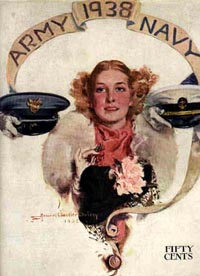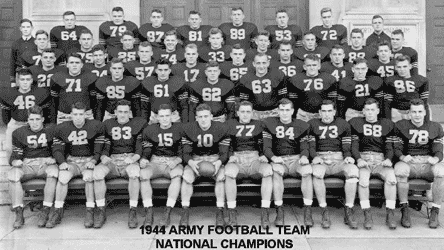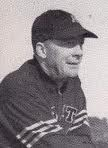
Earl Blaik
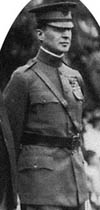
Douglas MacArthur

Biff Jones

Garrison Davidson |
Earl "Red" Blaik gained fame as the coach of West Point from 1941-1958, a tenure that included two straight national championship teams in 1944-5.
- Born in Detroit in 1897, Earl starred in football and baseball in high school in Dayton OH. He played football for three years at Miami (OH) University.
- Blaik entered The U.S. Military Academy, where he played football for another two years (1918-19). During his second year, General Douglas MacArthur became superintendent of the Academy. Blaik, older than his classmates, became a favorite of MacArthur, who made him chair of a cadet committee on the improvement of fourth classmen. MacArthur also proved to be a strong proponent of football at West Point.
- Blaik played basketball and baseball at the Academy and participated in track. One afternoon, MacArthur, who often watched his teams practice, gave Blaik pointers on how to hit the curveball.
- However, Earl excelled as an end, especially on D since Army rarely passed the ball. He quickly developed a reputation as a tough competitor who overcame adversity. Near the end of the 1919 season, he contracted a serious case of the influenza that was infecting the world. He was still in the hospital a week before the Navy game, which had already developed into a fierce rivalry that attracted national attention. However, he played in the game at the Polo Grounds and, though still weak, got in on many tackles. Near the end of the game, a finger to the eye knocked him out of the contest and back in the hospital. (Navy won 6-0.)
- Upon graduation in 1920, Lieutenant Blaik served in the U.S. Cavalry for two years. However, what he really wanted to do was coach football and, specifically, coach football at West Point.
So Blaik embarked on his coaching career.
- In 1924-5, he coached the ends at his other alma mater, Miami.
- After a year at Wisconsin, he returned to West Point as an assistant to "Biff" Jones. Blaik later credited Jones with teaching him the fundamentals of coaching, especially organization and meticulous preparation for the upcoming opponent. Jones led the Cadets to an 18-0 victory over Notre Dame and a 14-9 triumph over Navy. Having lost only to Yale, Army wound up in the top five in the informal polls of the day.
- Army enjoyed another successful season in 1928 with eight wins but two losses - to Stanford and Notre Dame. However, Army regressed to 6-4-1 in 1929, partly because its star RB, Chris Cagle, injured his shoulder. After the season, Jones was removed from his post since the Army high command considered coaching football at the Academy just another four-year assignment for an officer. (Several years later, Jones would be assigned to the ROTC program at LSU at the request of Huey Long so that Biff could coach the Tigers.)
- Major Ralph Sasse replaced Jones and kept Blaik on his staff along with another assistant, Gar Davidson, whom Blaik could not stand and who would prove to be his nemesis in his quest for the top job on the Plains. Under Sasse, Red became the disciplinarian of the staff, earning the unaffectionate nickname of "The Whip" from the players.
- The 1930 Cadet squad finished 9-1-1, the only loss coming to - who else? - Notre Dame. The 1931 season brought an 8-2-1 record, including a win over the Fighting Irish. However, the season was marred by the death of E Dick Sheridan in the fifth game. The tragedy deeply affected Sasse, who asked to be relieved after the 1932 season, which ended 8 up 2 down.
- Blaik saw his chance to fulfill his dream. He convinced Superintendant Eichelberger to waive the rule requiring the head coach to be an active duty officer. However, the Board gave the head job to Davidson. Earl had a major career decision to make.
|
|
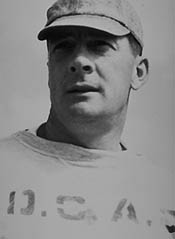
Earl Blaik at Dartmouth |
Earl Blaik was disappointed when, after six years at an assistant at West Point, he was passed over for the head job in favor of a man he did not respect, Garrison Davidson, who had graduated from the Academy eight years after Red. Unfortunately, Red had no place else to go. He had rebuffed feelers from Princeton and Ohio State during the 1932 season for their head coaching positions because he expected to be offered the Army job. So he bit his lip and stayed as Davidson's assistant.
- The 1933 Cadets had another outstanding season, 8-1, losing only the finale to a mediocre Notre Dame team.
- Before the ND contest, Ohio State again contacted Red, but Blaik felt he would not have the authority he wanted in Columbus. Yale sounded him out but hired one of its alumni for the job.
Then, when he had resigned himself to coaching under Davidson again, the opportunity he was waiting for finally arrived.
|
In January 1934, Dartmouth offered Blaik its head coaching position, promising him unprecedented control over the football program. Earl quickly accepted. He finally had a chance to implement MacArthur's philosophy that winning wasn't just anything, it was the only thing.
- Finding the Indian players (to use the school's nickname of that time) too soft, Blaik toughened his players with harsh practices even to the point of ignoring injuries.
- Earl professionalized Dartmouth football. He installed a complex single-wing O and kept his staff busy studying films, scouting opponents, developing new plays, and drilling the team at practice.
- The new regimen bore fruit immediately. Dartmouth shut out its first five 1934 opponents on the way to a 6-3 record.
- 1935 saw an improvement to 8-2. Then even better in 1936: 8-1 with a win over archrival Yale for the Ivy League title.
- Rewarded with a new contract, Blaik led the 1937 Indians to an undefeated 7-0-2 season, another league championship, and a #7 national ranking.
- 1938 brought a 7-2 mark but then only 5-1-3 in 1939.
- The Indians fell to 4-5 in 1940 but could take pride in upsetting Cornell in the famous "Fifth Down Game."
|
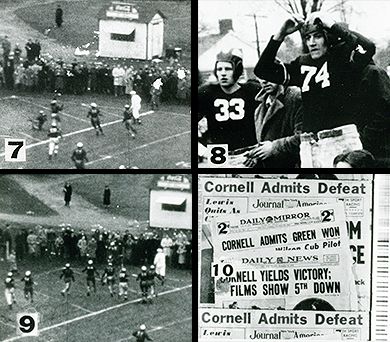
1940 Dartmouth-Cornell Game |
|
Meanwhile, back at West Point, football remained solid for awhile.
- Davidson compiled a 26-10-1 mark in his last four seasons.
- The 1938 squad, under Bill Wood, went 8-2, but the program took a nosedive after that.
- The Army began requiring cadets to be no taller than 6'4" and weigh less than 200 pounds. The Academy also began complying with college football's three-year eligibility rule, which barred players who, like Blaik in 1918, had played for other schools before their appointment.
- The results were predictable: 3-4-2 in 1939, which ended a remarkable run of 32 straight winning seasons, then 1-7-1 in 1940.
1941 brought a new superintendant to West Point, Brigadier General Robert L. Eichelberger, a protege of MacArthur who was determined to restore pride to Army football.
|
|
New West Point Superintendent Robert Eichelberger wanted Earl Blaik as his new football coach. One hitch in that plan was that Blaik would need his Army commission reinstated. Earl also insisted on two conditions: (a) He would bring his own assistants with him from Dartmouth and (b) the Army would rescind its height and weight restrictions for admission to West Point. Eichelberger granted or facilitated all of Blaik's demands. In so doing, he set the stage for the greatest era in Army football – aided by World War II.
- Blaik drove the 1941 Cadets hard to reinstill the discipline and toughness he felt had been lacking. They responded by winning the first four games. Even so, Notre Dame came to Yankee Stadium a heavy favorite under first-year coach Frank Leahy, who converted ND from the classic "Notre Dame shift" (single wing) to the T. In the rain and mud, Army held the mighty Irish to a scoreless tie. However, Blaik lost several key players to injury and his inaugural team limped to a 4-3-1 record, including a 14-6 loss to Navy on November 29. Eight days later, Pearl Harbor changed everyone's plans, especially at the service academies.
- In 1942, the Brave Old Army Team again won its first four before stumbling at Penn 19-0. Next up was Notre Dame. To prepare for the contest, Blaik had the plebe team run the Irish's T-formation plays. When they picked up the system easily, Earl decided to implement it for the varsity for '43. In the meantime, Yankee Stadium hosted another cold, wet, and miserable game thta ND won 13-0. After victories over Virginia Tech and Princeton, the Cadets again lost to Navy, 14-0, at Annapolis to finish 6-3. Blaik's system of coaching had proved itself with two straight winning seasons. However, Red was only 0-3-1 against the two biggest rivals, NDand Navy.
- Blaik took the first step to elevating Army football to a new plateau when he recruited RB Glenn Davis from California. However, Davis's grades didn't indicate much probability of success academically at West Point. So the football assistants helped Glenn and his brother prepare for the entrance exams. Thus began the spring tutoring for football prospects that became known as "Monster School." Blaik also established an extensive academic coaching program for his players during the school year. Thus were planted the seeds which, eight years later, produced the biggest scandal in Academy history.
- Showing improvement from 1942 at a time when most college teams were feeling the impact of military enlistment, the '43 T-formation Cadets swept through their first five games by a 211-7 margin. After a 13-13 tie with Penn, Army faced undefeated Notre Dame, whose All-American QB Angelo Bertelli was drafted right before the game. So sophomore Johnny Lujack, who had committed to Army before heading to South Bend, led the Irish to a 26-0 victory in the Bronx. Two more wins propelled the Cadets into their annual final game 7-1-1, but again the Midshipmen prevailed, this time at West Point, 13-0. Blaik still hadn't gotten over the hump against the most important opponents.
- In July 1944, Earl scored his biggest recruiting victory ever when FB Felix "Doc" Blanchard transferred from North Carolina. When Blanchard graduated from St. Stanislaus College in Bay St. Louis MS in 1942, numerous colleges recruited him, including Army. However, he chose UNC, in part because head coach Jim Tatum was his mother's cousin. Since freshmen were ineligible for the varsity, Doc played on the Tar Heel freshman team in 1942. When he tried to enter the officer training program at Chapel Hill, he was rejected because of his size (too big) and weak eyesight. So he enlisted in the Army and spent a year in the flying program. However, Blanchard's father, a physician (and the origin of the boy's nickname, which started as "Little Doc" when he was a boy), arranged for his son to take the West Point qualifying exams. When Felix passed, he entered the Academy as a plebe in the Class of 1947. Together with the other outstanding recruits in Blaik's 1943 and 1944 classes, many of whom were suspected of entering West Point to avoid the front lines for four years, Davis and Blanchard led Army to its greatest seasons ever.
|

Earl Blaik as Army Head Coach
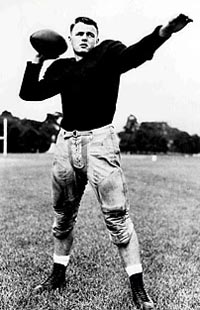
Glenn Davis
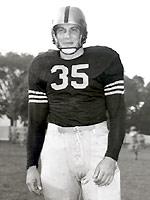
Doc Blanchard
|
|
Coach Red Blaik had his mind made up that 1944 would be the breakout season for his Army Cadets. Beside a shot at the national championship, Earl wanted to beat his nemeses, Notre Dame and Navy.
- Already known for being tough on his assistants, Blaik pushed his staff even harder including a New Year's 8 am meeting when many of his underlings showed up bleary-eyed. Part of the extra stress came from honing the T-formation offense he had installed in 1943. Red also installed several other innovations.
- The first was a platoon system, which had been used by other teams (such as Notre Dame under Rockne and Michigan in 1941) off and on over the years. The top two platoons would play both ways, but most of the younger prospects would be on the second team with a senior QB. This approach would not only wear down foes but also provide much experience for the greenhorns that would stand them in good stead for 1945.
- Blaik also instituted an academic help program for his players. Players having difficulty with what amounted to an engineering curriculum could draw on tutoring pools. Noble in purpose, the program eventually created the biggest embarrassment in the Academy's history. But that was seven years down the road.
- Ironically, 1944's first opponent was North Carolina, Doc Blanchard's former school. No contest – 46-0. Three more routs ensued: Brown 59-7, Pittsburgh 69-7, and Coast Guard 76-0.
- After four straight home games, the Cadets motored down the highway to the Polo Grounds to face Duke. The Blue Devils finally provided some opposition but still fell 27-7. The next week, Blaik felt so confident that his squad could handle Villanova (they did, 83-0) that he skipped the game to scout the next opponent, Notre Dame. Since the Irish played Navy in Baltimore, Earl killed two birds with one stone. The Midshipmen prevailed 32-13.
- The Irish were not the juggernaut of previous seasons. The war had depleted their ranks just as it had taken its toll on all other colleges, many of whom didn't even field a team that year. But that didn't dilute Blaik's glee in trouncing ND 59-0 at Yankee Stadium to gain revenge after 12 straight defeats. His only regret was that his rival coach Frank Leahy was serving in the military. Acting coach Ed McKeever said afterwards, "At least we got out of the game alive. We got it and got it good, but I think anyone who knows football knows we got it from a great team."
- A 61-0 cakewalk at Penn set up the annual Navy clash as the national championship game since the Midshipmen occupied the #2 spot in the rankings behind the Cadets. Originally scheduled for Thompson Stadium at Annapolis, the game was switched to Municipal Stadium in Baltimore because of the demand for tickets. To purchase a ticket, you had to buy a War Bond. $58,670,000 was raised from this effort. The Brave Old Army Team downed their archrival 23-7. After the game, a jubilant General Douglas MacArthur sent his protege Blaik a wire from the Pacific Theater: "THE GREATEST OF ALL ARMY TEAMS. WE HAVE STOPPED THE WAR TO CELEBRATE YOUR MAGNIFICENT SUCCESS."
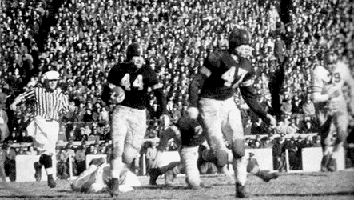 Navy
Navy moving the ball on Army in 1944
- Needless to say, Blaik got his national championship. Glenn Davis finished second in the Heisman voting to Les Horvath of Ohio State.
|

Earl Blaik

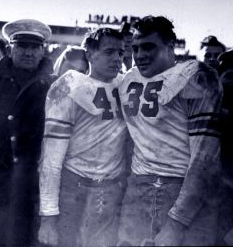
Glenn Davis and Doc Blanchard after the Navy game
|
|
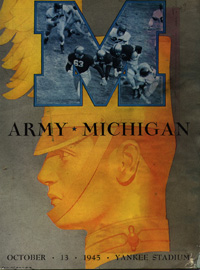
Army-Michigan Program 1945
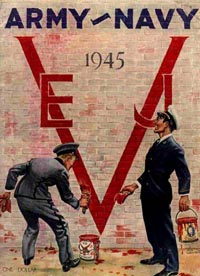
Army-Navy Program 1945
|
World War II ended in Europe in May 1945 and in the Pacific in early September. These events had little effect on the football season of 1945. It would take another year before players and coaches would rejoin their teams in great numbers.
Coming off the National Championship in 1944, the Army team of 1945 was widely expected to repeat. The Touchdown Twins, Blanchard and Davis, returned to the Black Knights (a name given the team by a sportswriter early in the '45 season). They were joined by other players who had played and even been stars at other colleges, such as "Shorty" McWilliams from Mississippi State.
- Army roared through the first two opponents.
- Louisville AAF 32-0 ("AAF" = "Army Air Force")
- Wake Forest 54-0
- Michigan fought hard but fell 28-7 at Yankee Stadium.

1945 Army- Michigan Action
- Three more massacres ensued.
- Melville R.I. (a Navy training base) 55-13
- Duke 48-13 at the Polo Grounds
- Villanova 54-0
- That cleared the decks for the annual battle with Notre Dame at Yankee Stadium. The Irish were crippled by injuries to several key players suffered in the 6-6 tie with Navy the previous week in Cleveland. That was the first blemish on ND's 5-0-1 record. Coached by Hugh Devore while Leahy remained in the Navy, the Irish were no match for the Cadets, 56-0.
- The season culminated with two games in Philadelphia.
- The Penn Quakers played like pacifists, losing 61-0.
- Navy fell at Municipal Stadium, 32-13, to finish 9-0 for the second straight year.
- Army finished #1 unanimously in the AP poll.
- Four Cadets made the consensus All-American team.
- T Tex Coulter
- G John Green
- HB Glenn Davis
- FB Felix Blanchard, who won the Heisman Trophy (which I have held in my hands after it survived Katrina at Doc's alma mater, St. Stanislaus College in Bay St. Louis MS)
West Point was invited to the Rose Bowl, but Blaik turned down the bid. He felt the team had nothing else to prove, and the players didn't want their semester exams and Christmas leave disrupted. |
|
1946 brought changes to West Point . New commandant, Maxwell Taylor, belived that "big-time college football as it developed after World War II did not fit readily into the West Point pattern of education." So he began to restore football to a less dominant position in the life of the cadets.
That initiative did not change the fact that Blaik had another solid team returning. The NCAA reinstituted the three-year eligibility rule. However, that affected only the plebes, who could not play varsity ball. Davis and Blanchard entered their senior season although Glenn still suffered from injuries sustained the previous season. Then Doc was hurt in the opening game of 1946, tearing several ligaments and a bone fragment in his right knee. After that, he was nowhere near the Heisman Trophy-winning player of 1945. At mid-season, QB Arnold Tucker also fell to the injury bug, sustaining a shoulder separation and sprained elbow that ended his passing prowess. Add the fact that most colleges had returned to full strength without competition from the military draft, and the new season would prove to be quite challenging for the defending national champions.
- Army won its first three games at home.
- Villanova 35-0
- Oklahoma 21-0
- Cornell 45-21
- A trip to Michigan produced a hard-earned 20-13 triumph.
- After dispatching Columbia at home 48-14, the Cadets traveled to NYC to take care of Duke 19-0. Then West Virginia succumbed on the Plains above the Hudson by the same 19-0 tally.
- Notre Dame came to Yankee Stadium for the annual big game with a rejuvenated squad led by Blaik's nemesis, Frank Leahy. The "Game of the Century" between the two undefeated, untied teams ended 0-0, settling nothing about who's #1. The key play occurred in Q4, when Blanchard broke into the open down the sidelines. However, Irish QB/S Johnny Lujack overtook him and brought him down on the sideline, something that wouldn't have occurred when Doc was at full speed. Leahy reportedly cried after the game and kept his staff up late into the night analyzing why his team had not scored on Army.
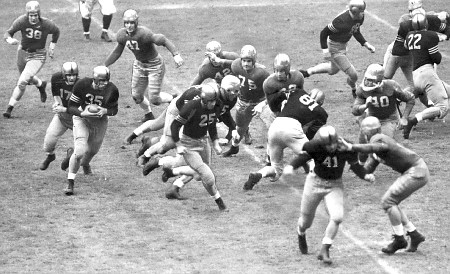
Army- Notre Dame Action 1946
- Army overran Penn 34-7 before defeating Navy 21-18 thanks to three Q4 stands inside the four.
- Army finished 9-0-1 and Notre Dame 8-0-1. The AP voted the Irish #1. Neither team, as usual, played in a bowl game.
- It was Davis's turn to win the Heisman Trophy.
The 1946 Army-Notre Dame game had generated the greatest national interest in the history of college football in a country returning to normal after the war.
- An estimated $5,000,000 had been bet on the game. The 0-0 finish produced a big profit for the bookmakers and also caused betting establishments to start allowing customers to bet on the point spread as well as which team would win.
- The administrations of both schools were concerned that they would no longer be able to keep football within its proper place in an academic institution. In addition, lots of bad blood had developed between the contestants. When the 1947 game produced another gambling orgy, the series was terminated, not to resume for ten years.
West Point's leaders also faced the problem of growing animosity toward the football program at the military school. Resentment had built up because the program was viewed as a haven for players wishing to avoid the draft during WW II. Within the academy, many cadets and professors felt that Blaik and his staff had recruited players who could not meet the academic requirements of the institution.
|
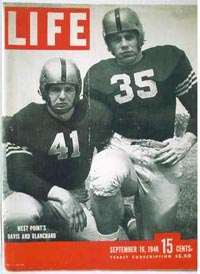
Davis and Blanchard at start of 1946 season
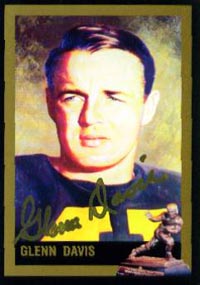
|
|
1947 was Coach Blaik's first season after The Touchdown Twins (Davis and Blanchard) graduated. After four games, the Cadets stood 3-0-1 thanks to a 0-0 tie with Illinois. Their undefeated streak had reached 32. Many expected it to last until the annual Notre Dame game November 8 at South Bend. However, Columbia had other ideas.
- In his pre-game remarks to the team at Baker Field, Blaik said, "You are not ready for this game. If we don't snap out of it, we're going to get licked. I'm going to give the starting team five minutes to score. Otherwise they'll be out of there."
- The first-stringers pushed across a TD with 30 seconds to spare but the Lions had already taken an early lead.
- After a back-and-forth game, Columbia prevailed 21-20.
Notre Dame got its revenge, 27-7, in the last scheduled game of the storied series. The schools would not play again until 1957. Blaik's squad finished the '47 season 5-2-2, their worst record since Blaik's first year in 1941.
The Cadets rebounded with three straight outstanding seasons: 8-0-1 in 1948, 9-0-0 in '49, and 8-1-0 in '50. One of the new assistants for the '49 season was Vince Lombardi, who replaced Sid Gillman. Both men would go on to fame in professional football. Lombardi credited Blaik with greatly influencing his coaching philosophy.
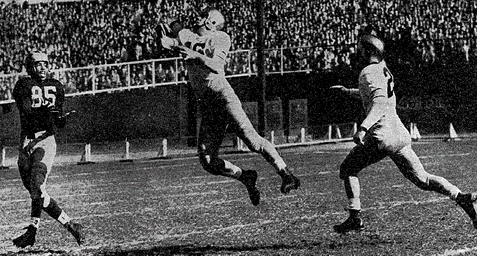
Army-Michigan 1950; the year before the Cadets ended UM's 25-game winning streak.
The only damper on Army's three-year run was the 21-21 tie with Navy in '48 and a 14-2 loss to the Midshipmen in '50. Football was more than surviving its alleged de-emphasis at the Academy. However, the bottom was about to fall out of Red's world.
The 25-1-1 three-year record had been achieved in part because of Blaik's "tutoring" program that both helped recruits gain admission to the academy and then maintain their eligibility once enrolled. However, the program was evolving into a cheating ring rather than just academic assistance. Some football players were not just being tutored for exams but were actually being provided with questions and answers in advance, either from the tutor or from another cadet who had taken the test in an earlier section of the course. Members of "the ring" had infiltrated the cadet Honor Committee, which oversaw the honor code of conduct.
A growing number of the West Point faculty, already resentful of the special treatment given Blaik's players, suspected that something more than tutoring was at work. Furthermore, some of the 20 cadet tutors had begun to notice irregularities that greatly troubled them because they represented violations of the honor code. The most egregious example was giving the tutor a "practice" test to cover with his tutoree which turned out to be the actual test.
The conspiracy began to unravel during the second semester of the 1950-1 school year. Perhaps no one was more responsible for peeling away the layers of the onion than Lt. Col. Arthur S. Collins, 1st Regiment commander at the academy, who was known for his dislike for football players. Collins began investigating the special privileges afforded Blaik's squad members. The guilty consciences of several cadets who had been drawn into the conspiracy caused them to tell Collins about what had been going on. This led to a wider investigation that unraveled the scheme.
In August 1951, 90 cadets were expelled either for their involvement in the ring or for not reporting honor code violations as they were sworn to do. 37 of the dismissed were football players, including Earl Blaik's son Bob, who was scheduled to be the starting QB in 1951. Blaik himself was shocked by the scandal. He had left underlings to run the academic assistance program and had no idea of the corruption that had set in.
The depleted 1951 squad finished 2-7. The following year was better (4-4-1), but it wasn't until 1953 that Army football regained its sold footing.
|
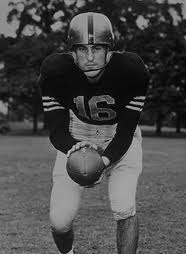
Arnold Galiffa, Army QB 1947-9 and Korean War hero
|
|

Pete Vann and Don Holleder

Pete Dawkins
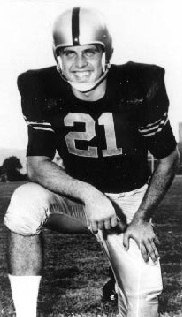
Bob Anderson
|
As the 1953 season dawned, the Army football program was still trying to regain its equilibrium after the fallout from the Cheating Scandal of 1951. Coach Blaik now benefitted from having to play youngsters in '51 and '52 after 37 players were expelled.
- The '53 Cadets, most of whom had lost to Navy 42-7 as sophomores in '51, defeated the Midshipmen 20-7.
- Army finished 7-1-1, the loss coming at Northwestern 33-20 and the tie at Tulane 0-0 (a game I attended).
- West Point won the Lambert Trophy as Eastern champions. The Washington Touchdown Club selected Blaik as Coach of the Year.
- Earl was offered the heading coaching job of the New York Giants but declined. However, the Giants did sign Blaik's top assistant, Vince Lombardi, as an assistant coach.
The Cadets continued their winning ways for the next five years.
- The 1954 Army squad featured an explosive offense that ran well and also employed the passing of QB Peter Vann to Don Holleder. Blaik's boys finished #7 in the AP poll with a 7-2 record. However, the season was dampened by a 27-20 loss to Navy in the annual finale.
- With most of his '54 starters lost to graduation, Blaik moved Holleder, one of the best receivers in the nation, to QB for the next season. Despite the fact that he wasn't happy with the move, Don led the Cadets to a 6-3 record, including a 14-6 triumph over the Middies. Holleder served with distinction in the infantry until being killed in combat in Vietnam. The basketball/hockey arena at West Point is named the Holleder Center.
- The '56 Brave Old Army Team survived 40 fumbles to eke out a 5-3-1 record thanks to some creampuff foes like VMI, Colgate, and William & Mary. The tie was against Navy, 7-7.
- Army renewed its rivalry with Notre Dame in 1957 after a ten-year hiatus. Several young players showed promise, particularly E Bill Carpenterand backs Pete Dawkins and Bob Anderson. The 7-2 slate included a 23-21 loss to the Irish in Philadelphia and a 0-14 setback to guess who in the final game.
- 1958 held great promise and delivered. Led by Dawkins, who was also president of his class, the Cadets recorded their first unbeaten season since 1949. The only blemish in nine contests was a 14-14 tie at Pittsburgh. The 14-2 victory at Notre Dame was particularly gratifying to Blaik. He showed creativity by making Carpenter his "Lonely End" who was flanked far to the outside in an era when that was almost unknown. Since he didn't want Bill wasting energy running to and from the huddle, Red developed a set of signals that allowed the QB to tell Carpenter the play. Ranked #3 at the end of the season, the Brave Old Army Team received an invitation to the Cotton Bowl. Blaik had always opposed post-season games, not wanting to disrupt his players' preparation for semester exams and take away their Christmas holidays. But this time Dawkins asked him as the season drew to a close to consider accepting a bid. However, the superintendent, Blaik's old nemesis, Gar Davidson, issued a directive that Army would not accept any bowl bid.
 Davidson also split the position of AD from that of head football coach. Gar wanted to stop what he saw as a trend to reinstate football to the exaggerated status it enjoyed during and right after World War II. This decision, plus the fact that he felt that he had reestablished Army football on a sound foundation following the great scandal, persuaded Blaik to submit his resignation as football coach.
His 17 seasons at Army produced a 121-32-10 record. He went 8-8-2 against Navy. Red remains the winningest coach in West Point history.
He stayed active after his retirement from coaching.
- Blaik became a vice president at the Avco Corporation.
- In 1964, he was elected to the College Football Hall of Fame.
- His other alma mater, Miami University, honored him by induction into the university's Athletic Hall of Fame in 1969.
- Earl received the Presidential Medal of Freedom from President Ronald Reagan in 1986.
- Blaik died at age 92 in Colorado Springs, Colorado.
- In 1999, the football field at West Point's Michie Stadium was named Blaik Field in his honor.
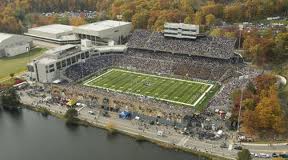
Blaik Field at Michie Stadium, West Point
|
|
|
CONTENTS
Earl Blaik - I
Earl Blaik - II
Earl Blaik - III
Earl Blaik - IV
Earl Blaik - V
Earl Blaik - VI
Earl Blaik - VII
Earl Blaik - VIII
Football Profiles - I
Football Profiles - II
Football Profiles - IV
Football Profiles V
Football Profiles - VI
Football Magazine
Golden Rankings Home
Top of Page
|






